Authentic German Lebkuchen
This post may contain affiliate links. See my disclosure policy.
Dating back to the 14th century in Nuremberg, Germany, Elisenlebkuchen have stood the test of time as one of Germany’s most popular and beloved of all Christmas treats. And having eaten more Lebkuchen in my life than I care to admit, I can promise you that absolutely nothing beats homemade. You’ll fall in love with this authentic German Lebkuchen recipe, made after traditional Nürnberger fashion.

Having grown up in Germany it’s the Christmas season when I get the most homesick. The snowy landscapes, the decorations, the Christmas markets, and all the delicious Christmas goodies…you just can’t beat Christmas in Germany. One of Germany’s most famous Christmas treats (and one of my personal favorites), is Elisenlebkuchen, and that’s the German Lebkuchen recipe I’m sharing today. (Be sure to check out all of my favorite traditional German Christmas Cookies!)
What is Lebkuchen?
Lebkuchen go all the way back to 14th century Germany where they were created by Catholic monks. Prepared in monastery bakeries, Lebkuchen included honey, a variety of spices and nuts. These ingredients not only had symbolic religious meaning but were highly prized for their healing properties. Those clever monks not only created an exceptionally delicious sweet treat, they found an additional use for their communion wafers: They increased the diameter size and used them as the base for the sticky gingerbread dough – a perfect solution.
A quintessential sweet treat throughout all of Germany during the Christmas season, Lebkuchen is one of the most popular and beloved of all German holiday confections. There are a variety of German Lebkuchen, each distinguished by slight alterations in ingredients and most especially the amount of nuts used. But the most highly prized of all are the Nürnberger Elisenlebkuchen. The title is a regionally protected one and only Lebkuchen produced in Nürnberg can be sold as such. The distinguishing characteristic of the Elisenlebkuchen is that they use no flour and have a very high ratio of nuts, specifically a combination of almonds and hazelnuts.
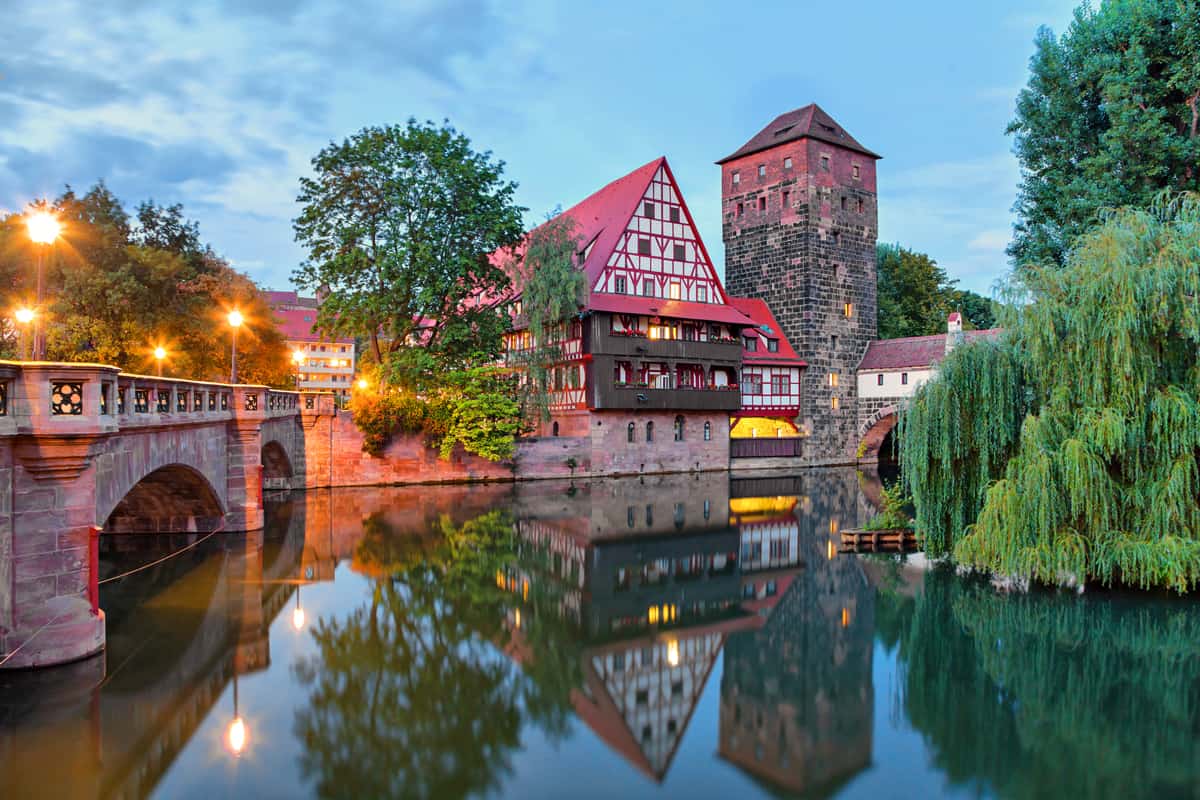
Lebkuchen Key Ingredients
Beyond the basic ingredients of nuts, sugar, eggs, etc, there are three key ingredients that you need to make Lebkuchen. Let’s take a closer look at them:
What are Backoblaten?
An essential item for Elisenlebkuchen are Backoblaten which are very thin wafers that serve as the base for the Lebkuchen. You can get Backoblaten in three sizes: 90mm, 70mm and 50mm. 50mm is mostly used for smaller items like cookies. You can use either 90mm or 70mm for the Lebkuchen depending on how large you want them. Amazon currently has the 70mm oblaten available. Alternatively, you can also use white communion wafers.
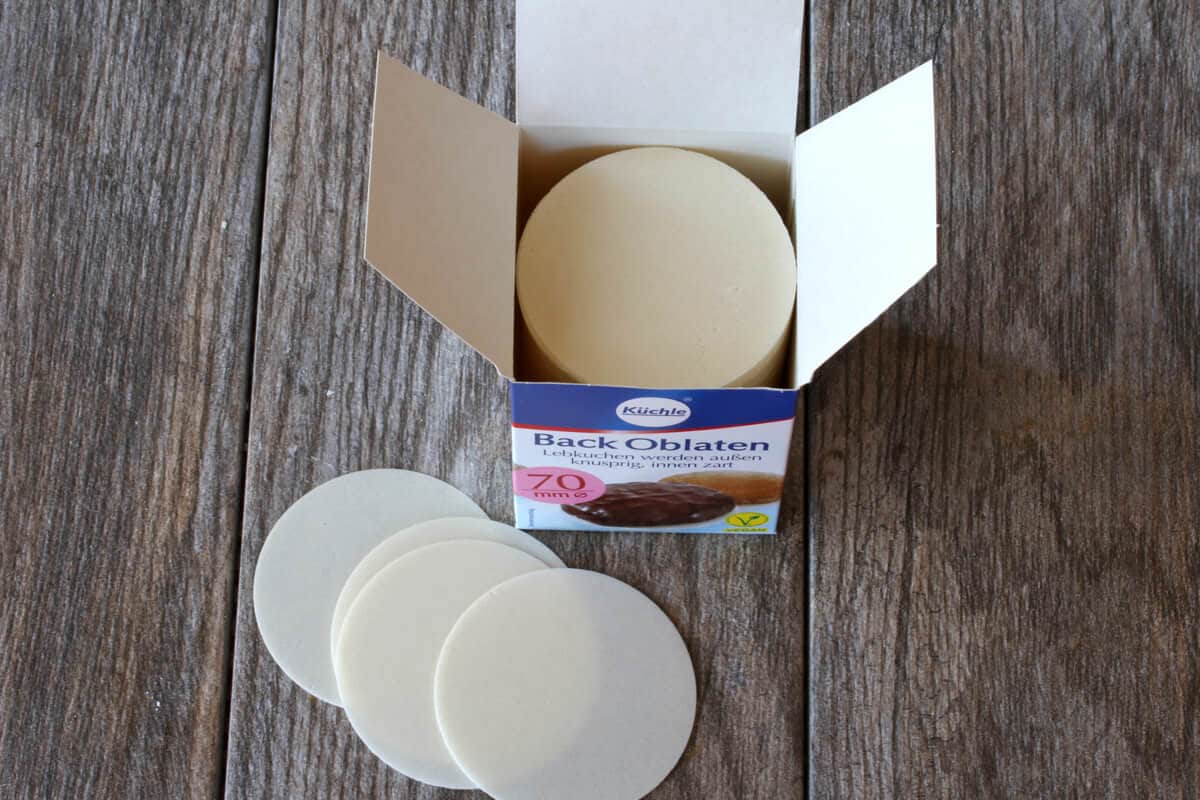
What is Lebkuchengewürz?
An absolutely critical ingredient in these Lebkuchen is Lebkuchengewürz. You cannot make these without Lebkuchengewürz. Period. Not if you want them to taste like real Lebkuchen. And Lebkuchengewürz is virtually impossible to find here in the U.S. unless you’re lucky enough to have a well-stocked German grocery store near you. But have no fear because I’ve got you covered!
Here is my recipe for homemade Lebkuchengewürz, an absolutely magical blend of spices. And even if you find some store-bought Lebkuchengewürz locally or online I still recommend that you make your own because it’s a hundred times better! A richer, deeper, more vibrant flavor. If you add this homemade Lebkuchengewürz to any authentic German recipe calling for Lebkuchengewürz you’ll close your eyes and feel like you’re back in Germany.
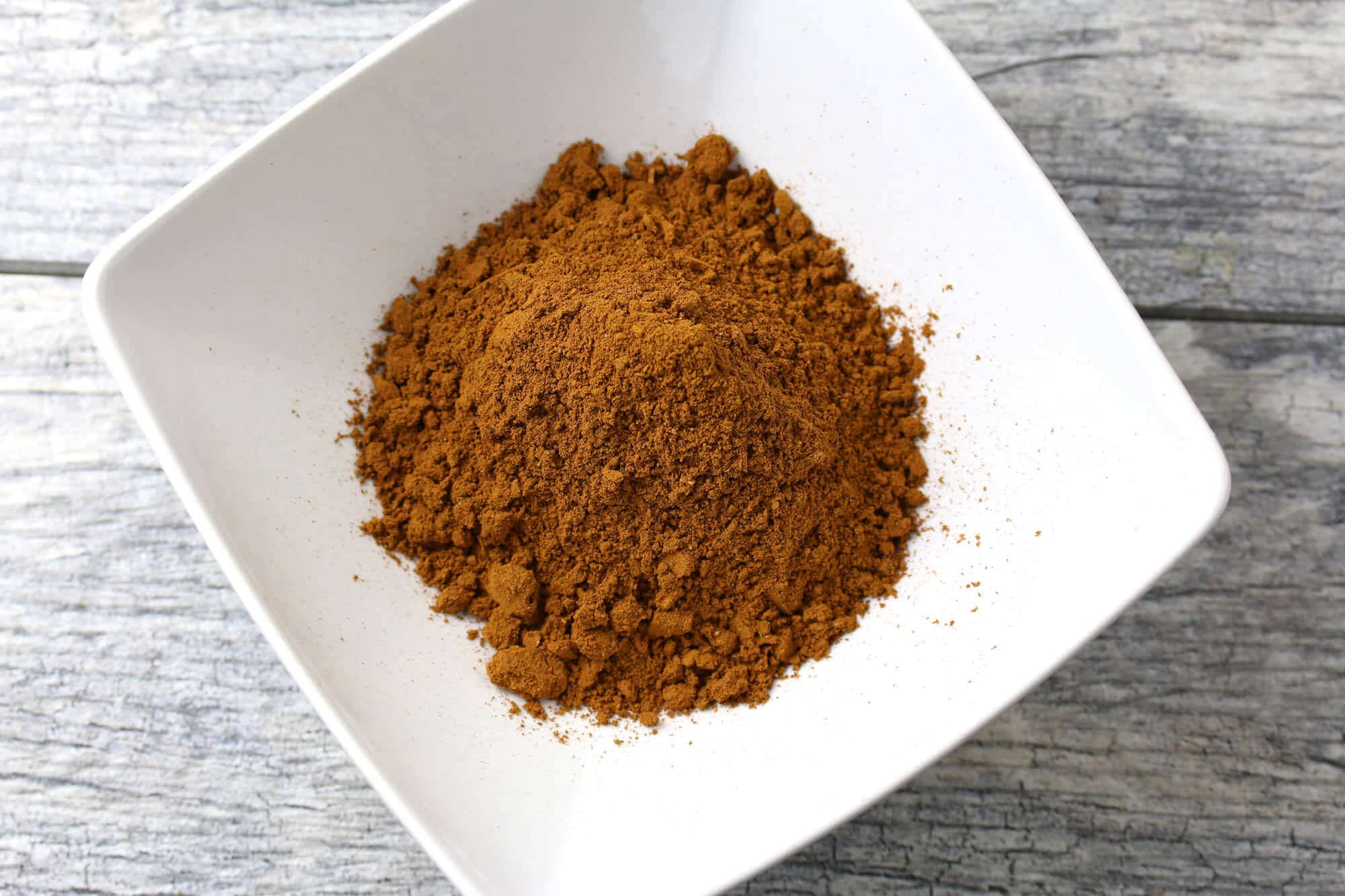
Homemade Candied Citrus Peel
I single this one out as a key ingredient because I emphatically maintain that homemade is essential. Virtually everyone I know detests store-bought citrus peel and I’m in full agreement. The stuff tastes like chemicals. No matter the brand, store-bought candied lemon and orange peel is just super yucky. And it’s a shame because a lot of Christmas baked goods call for candied citrus peel and people buy it because they think they have no other options. But there IS another option. And if you’ve ever put off making things like fruit cakes or German Lebkuchen because you hate that store-bought, chemical-flavored stuff in the plastic container, let me tell you: Homemade candied citrus peel is a 100% deal changer. Not only does it taste good, it tastes amazing and it will make your baked goods taste even more amazing! (Also, while not traditional, you can also include some Candied Ginger if you like.)
Please, please do yourself a favor: Put that store-bought stuff back on the shelf and make some Candied Orange Peel and lemon peel. Your life will change forever!

With these essential ingredients in hand you’re ready to make some seriously amazing homemade Lebkuchen. Growing up in southern Germany I always looked forward to when the Elisenlebkuchen came available. And as good as the store-bought ones are, wait till you try homemade! The texture and flavor of these Elisenlebkuchen is sublime. They keep for a long time and their flavor only gets better the longer they sit and the flavors can ripen. For a truly unforgettable German Christmas pastry, you must give these traditional German Lebkuchen a try!
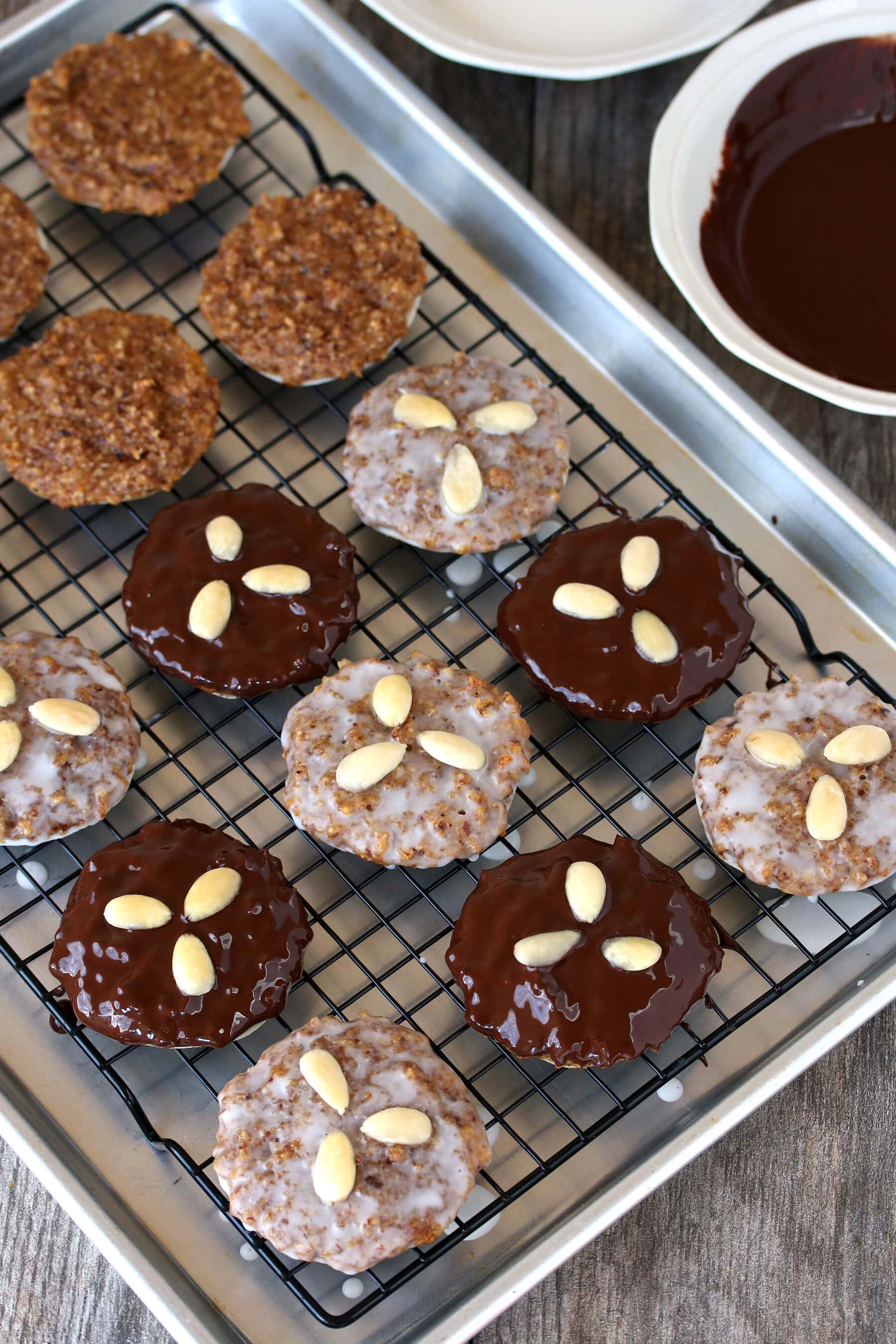
German Lebkuchen Recipe
Let’s get started!
Be sure to also check out my video in the recipe box. And on a side note, here’s a little trivia for you classical music lovers. I chose Pachelbel’s Canon as the backing track to my video. Can any of you guess what Pachelbel has to do with Nürnberger Elisenlebkuchen? Answer: Pachelbel was from Nürnberg.
You can use a hand mixer or a stand mixer. Place the eggs in a large bowl and beat the eggs until foamy.
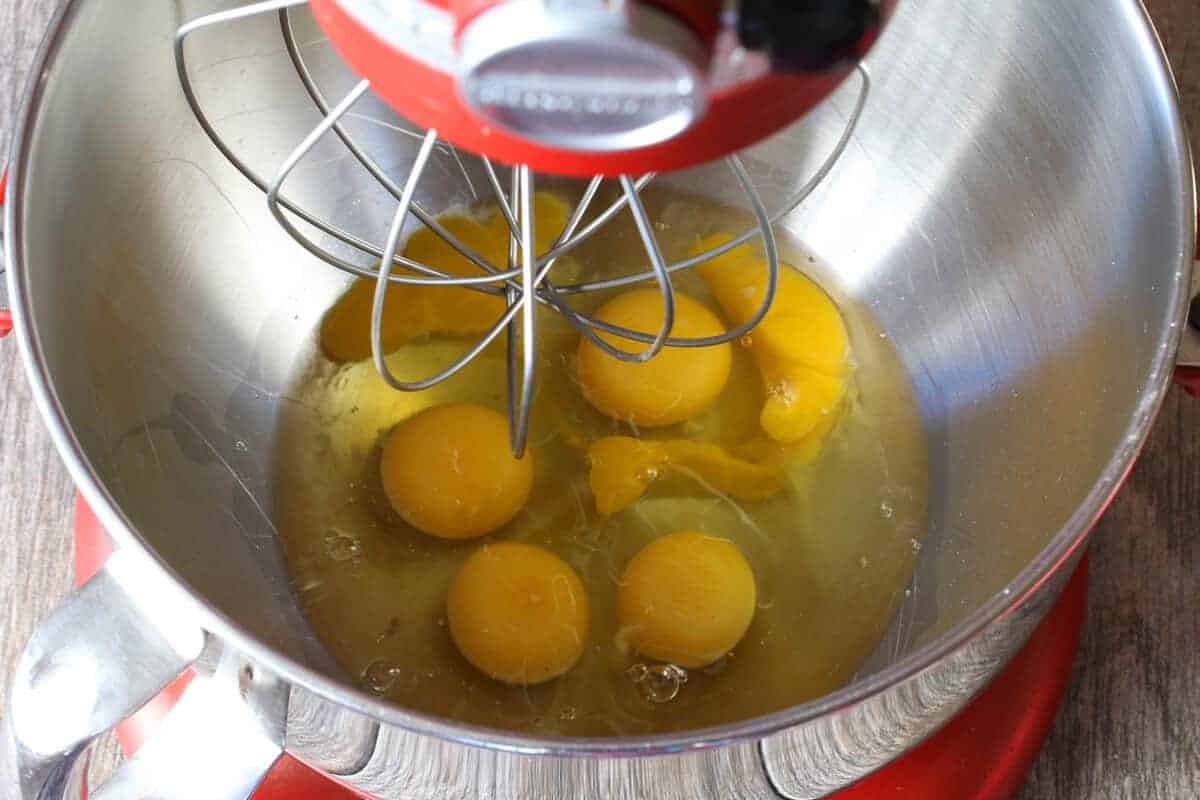
Add the brown sugar, honey and vanilla extract. Beat until combined.

Finely mince the candied lemon and orange peel. The best way to do that is to place them in a bowl and toss them with about 1/4 cup of all-purpose flour to prevent them from sticking together.
Note: If you want truly amazing results, make your own candied citrus peel. The flavor is amazing. It’s super easy to make and once you’ve tried it you’ll never get the store-bought stuff again! Here is my recipe for candied orange peel and lemon peel (same method for both).
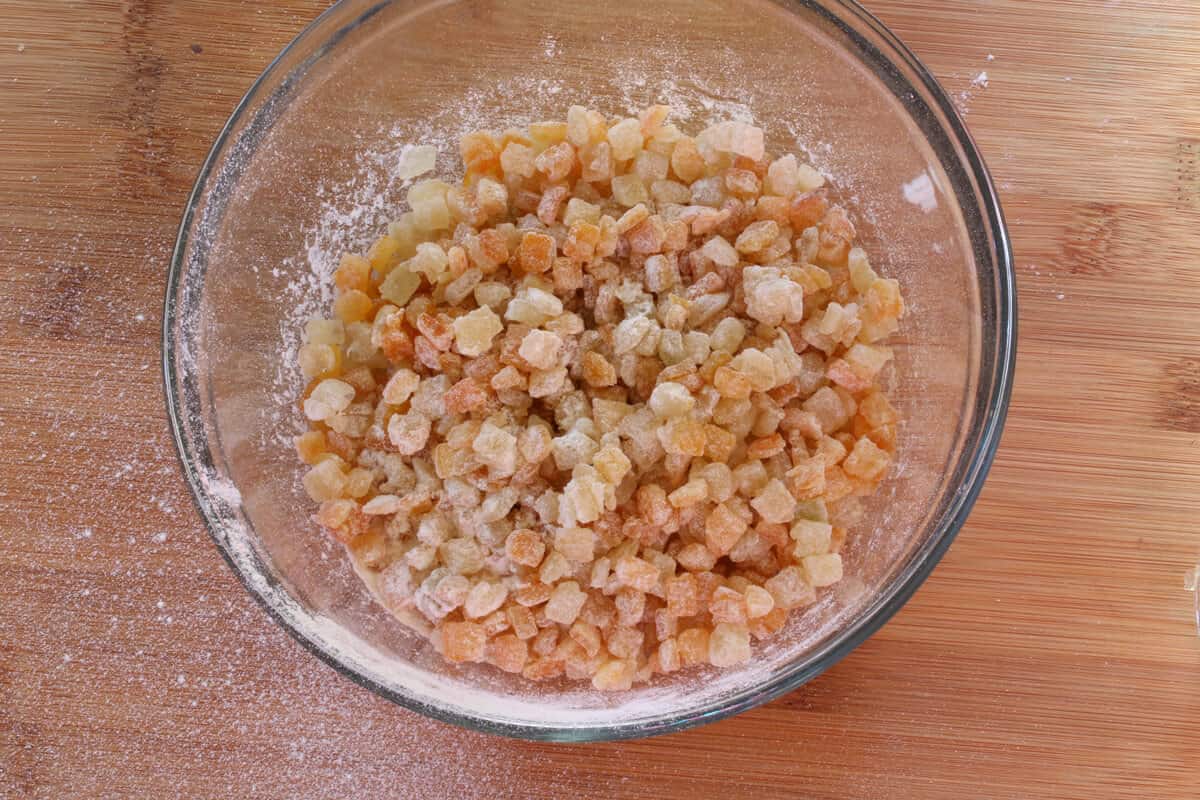
Place it in a food processor and pulse until finely minced.

Add the nuts, salt, baking powder, Lebkuchengewürz and candied lemon peel.
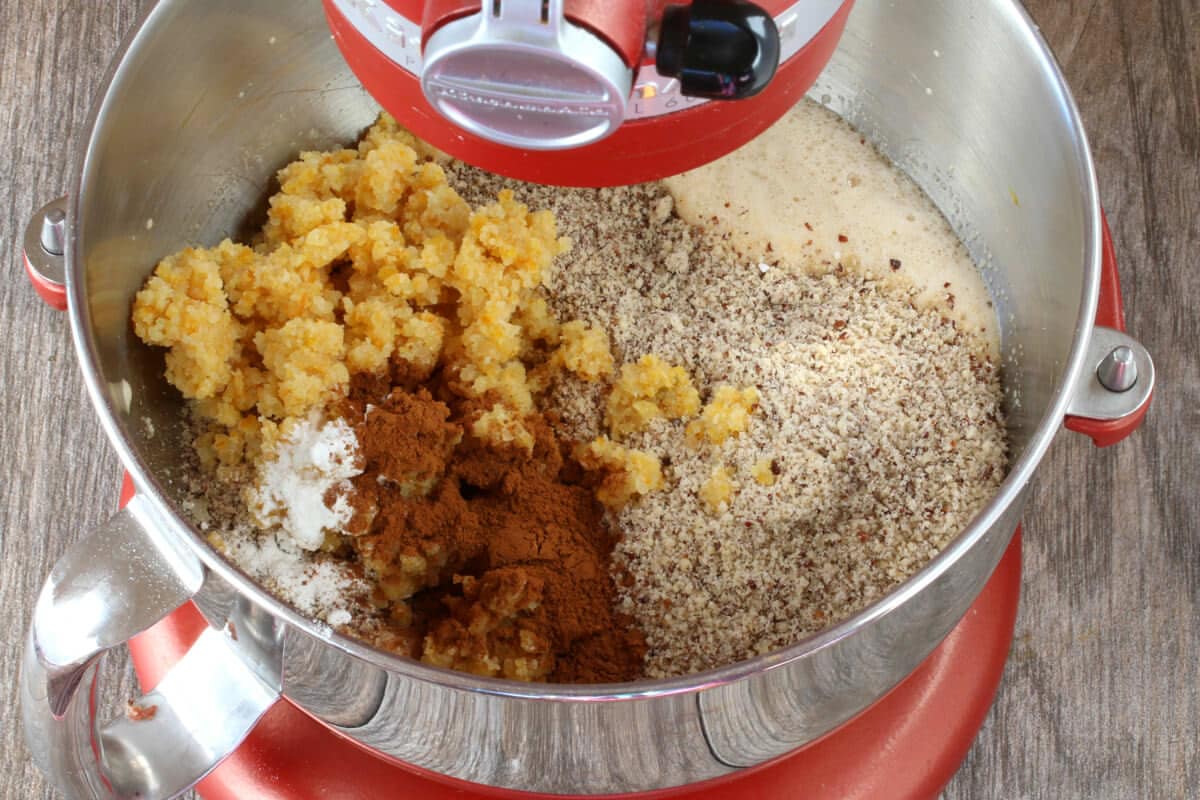
If using a stand mixer, use the paddle attachment and beat on medium for about 2 minutes until thoroughly combined. If you’re not using a stand mixer, beat vigorously with a wooden spoon until thoroughly combined.
The mixture will be wet. If it’s too runny to scoop onto the oblaten add some more almond or hazelnut meal.
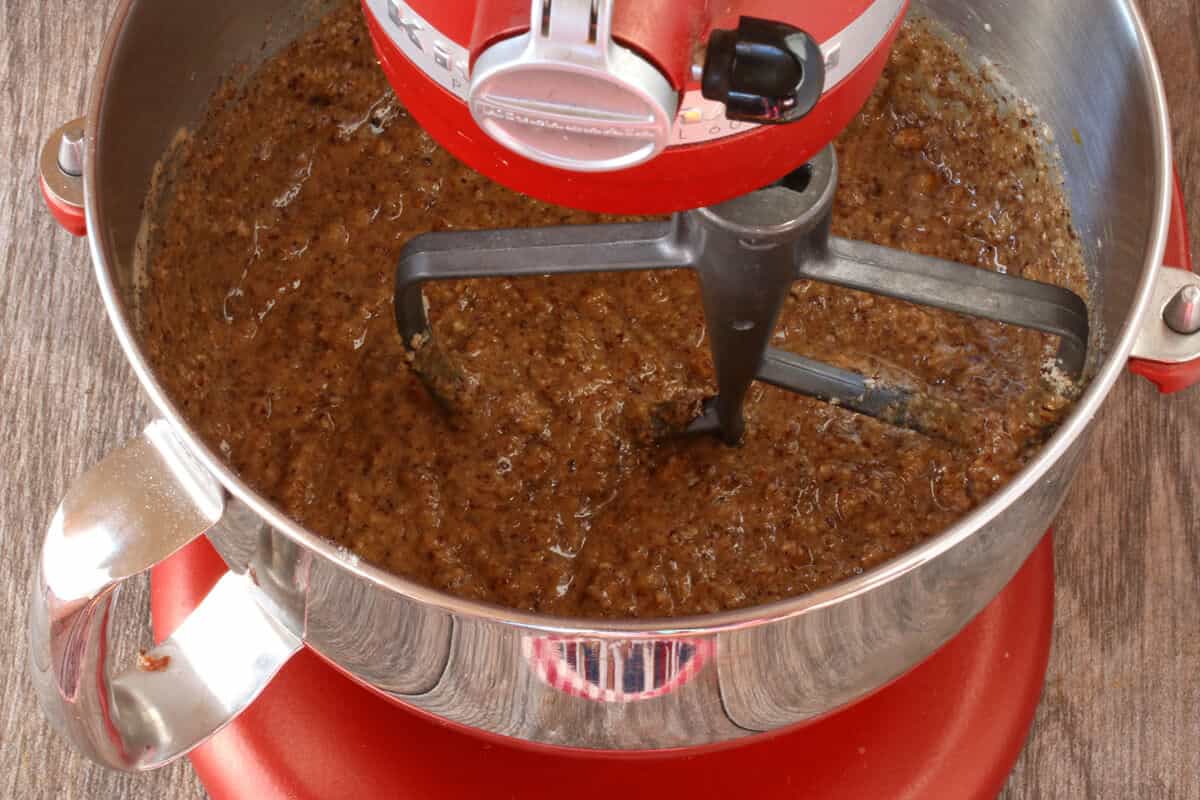
Scoop some of the mixture onto the Backoblaten, smoothing the top and leaving just a tiny bit of an edge around the rim. Place them on a lined cookies sheet.
In an oven preheated to 300 degrees F, bake the Lebkuchen on the middle rack for 25-28 minutes. Remove and let cool completely.
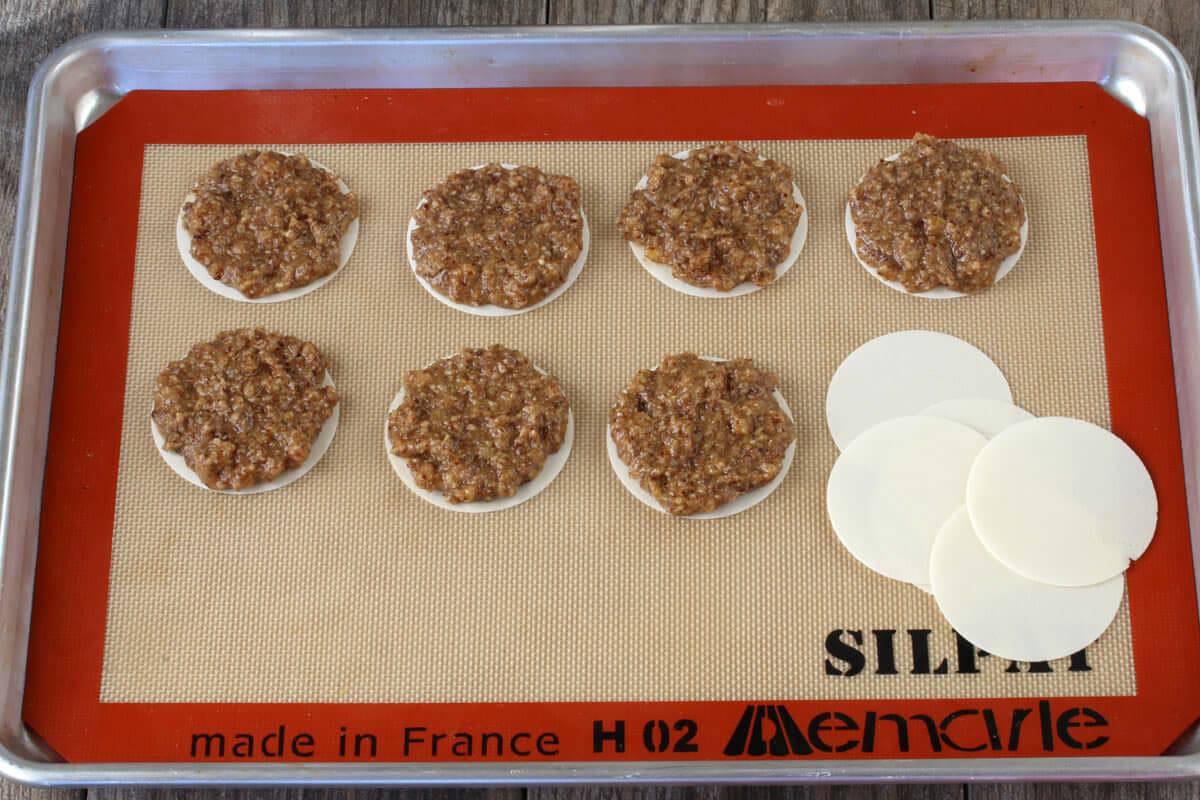
Once the Lebkuchen have cooled, make the glaze. For the chocolate glaze, add the chocolate and oil (I use and love coconut oil for this) and a small bowl and microwave, stirring occasionally, until melted. You’ll want to use it immediately as it will start to firm. If it does firm up simply reheat it for a few seconds in the microwave.
For the sugar glaze, in a small bowl combine the powdered sugar and water and stir until smooth.
Traditionally Lebkuchen are made with these two glazes and some are kept natural (no glaze). Choose whatever you prefer. Chocolate-dipped Lebkuchen have always been my favorite.
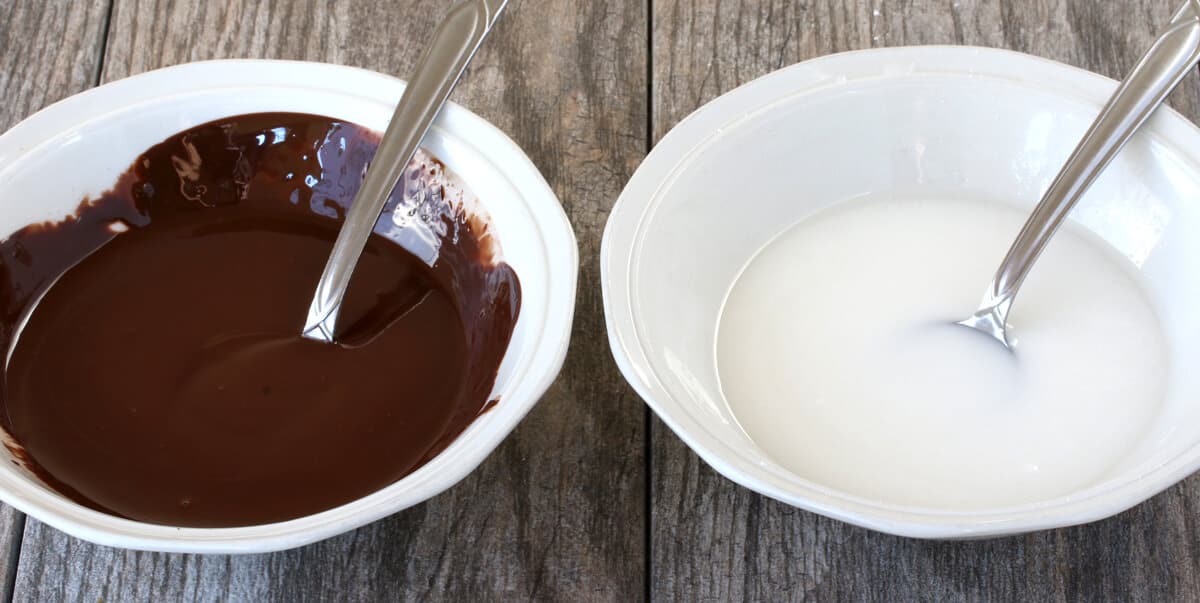
Position a wire rack over a cookie sheet to catch the drippings.
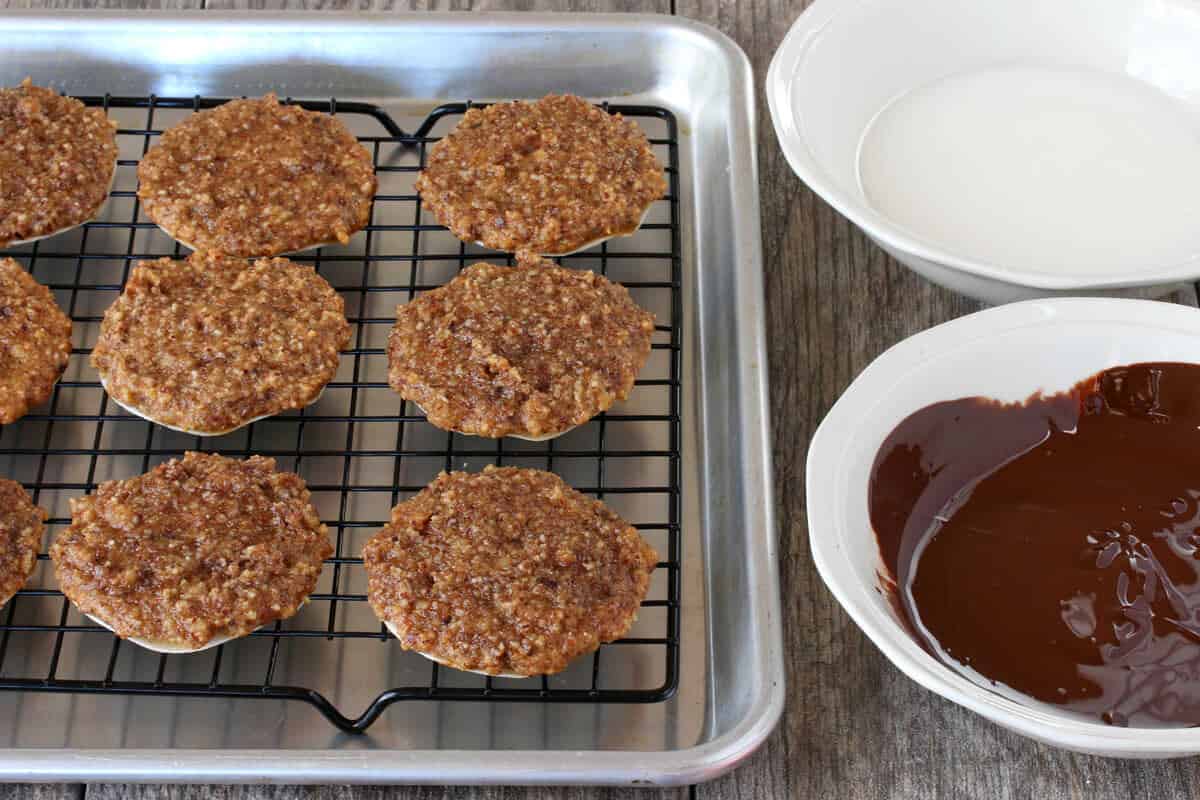
Dip the Lebkuchen into the glazes, letting the excess drip off and placing them on the wire rack to set. Place three blanched almond halves on each Lebkuchen while the glaze is still wet. Let the Lebkuchen sit undisturbed until the glaze is fully set.
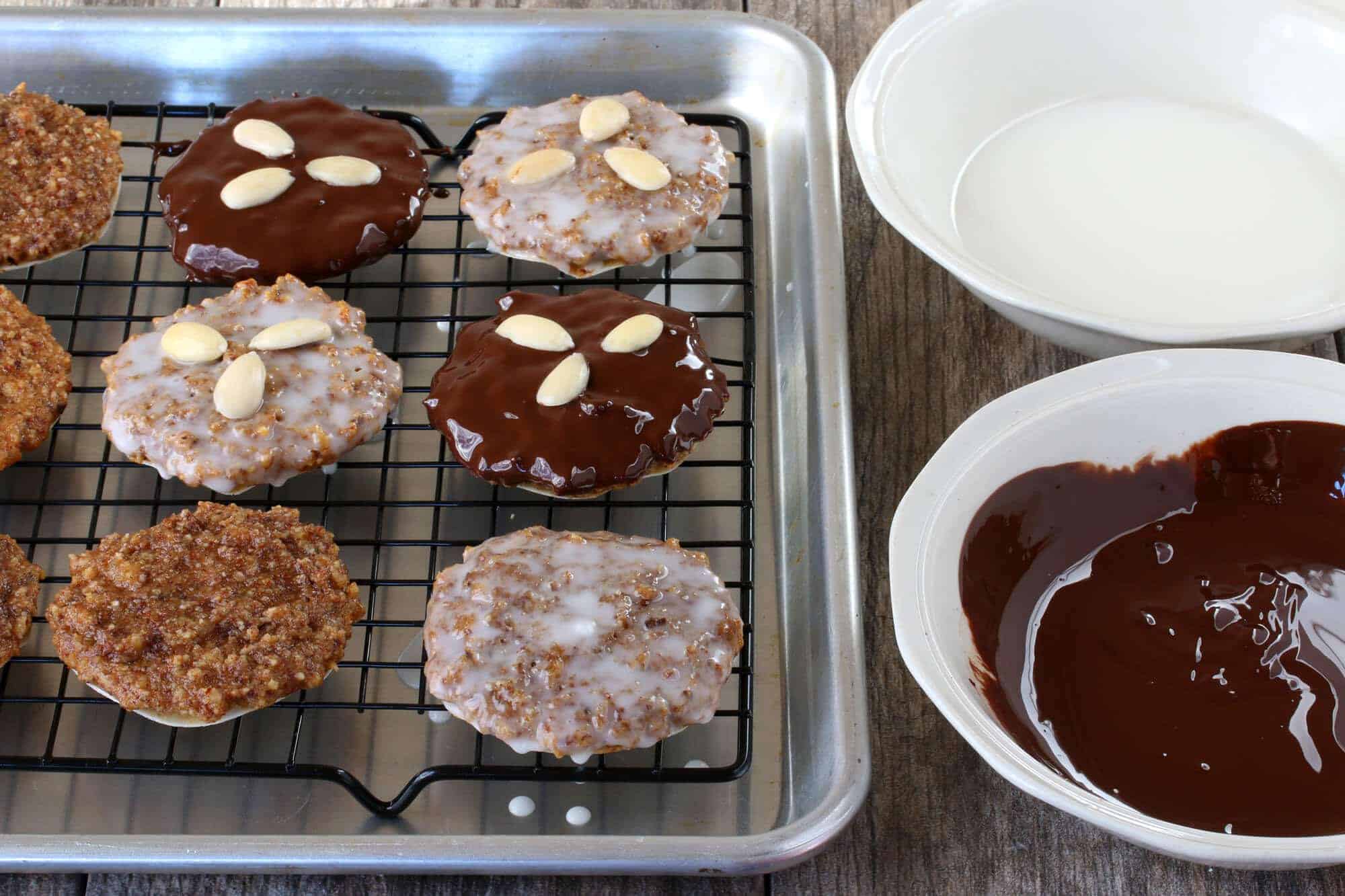
Keep the Lebkuchen stored in an airtight container where they will keep for a few weeks. And their flavor only gets better with time.
Enjoy!
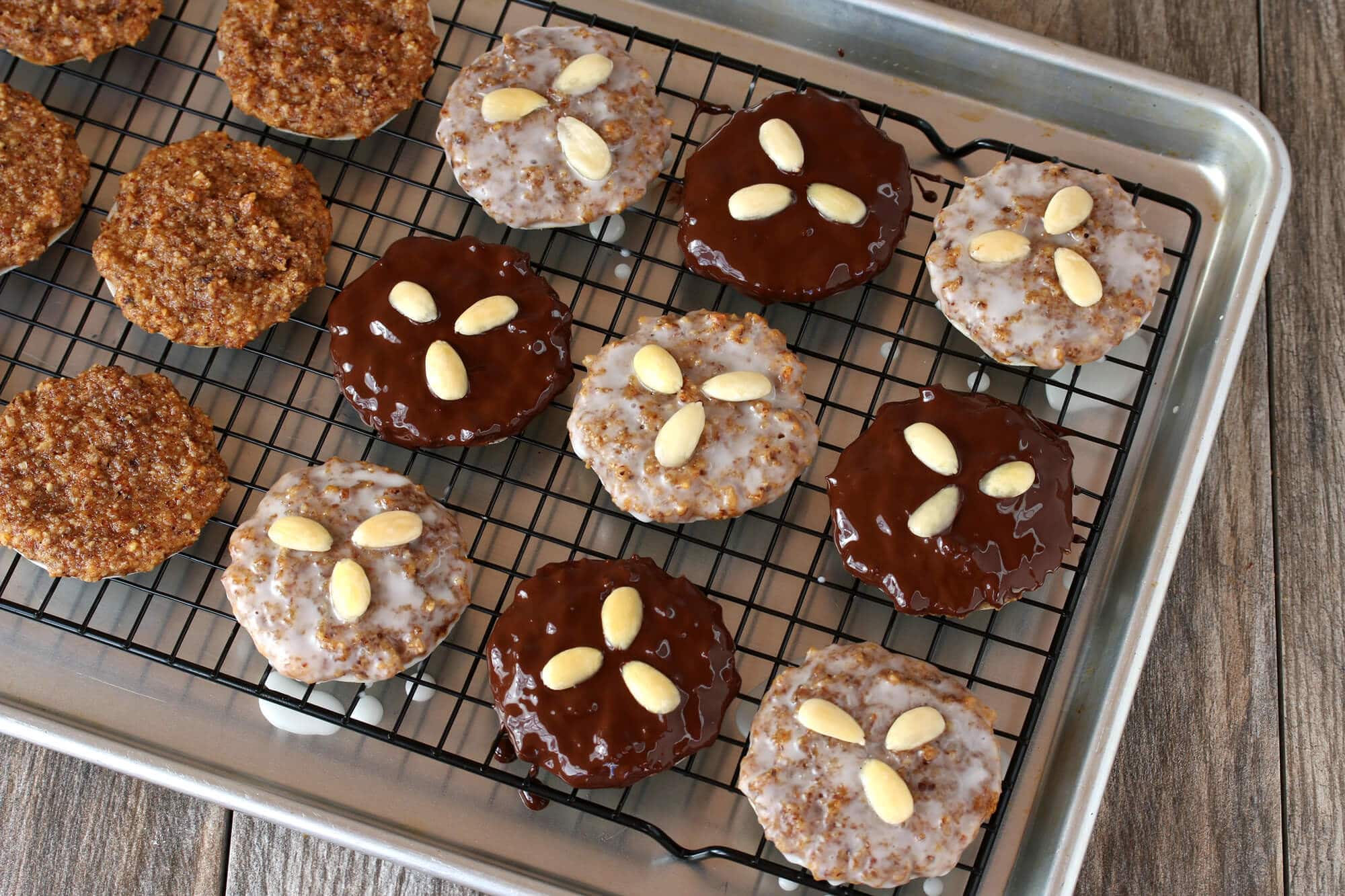
For more delicious and authentic German Christmas recipes try my:
- Stollen
- Pfeffernüsse
- Springerle
- Printen
- Marzipan
- Speculoos
- Vanillekipferl
- Zimtsterne
- Spitzbuben
- Bethmännchen
- Heidesand
- Gugelhupf
- Magenbrot
Save This Recipe

Authentic German Lebkuchen
Equipment
- Backoblaten , either 70mm or 90mm
Ingredients
- 5 large eggs
- 1 1/4 cup packed brown sugar
- 1/4 cup honey
- 1 teaspoon quality pure vanilla extract
- 2 cups almond flour
- 2 cups hazelnut flour
- 1/4 teaspoon salt
- 1/2 teaspoon baking powder
- 3 teaspoons Lebkuchengewürz
- Homemade Lebkuchengewürz , (STRONGLY recommended), click link for recipe
- 4 ounces candied lemon peel
- 4 ounces candied orange peel
- 1/4 cup all-purpose flour (to coat the candied peel) (can substitute gluten free)
- Homemade Lemon and Orange Peel , click link for recipe (STRONGLY recommended instead of store-bought!)
- Backoblaten either 70mm or 90mm
- or white communion wafers (these can be substituted for Backoblaten)
- Blanched whole almonds cut in half lengthwise
- For the Chocolate Glaze:
- 3 ounces quality dark or milk chocolate
- 2 teaspoons coconut oil or oil of choice – do not use butter
- Directions: Place chocolate and oil in a small bowl and microwave stirring occasionally, until melted. Use immediately. If glaze becomes firm, reheat in the microwave.
- For the Sugar Glaze:
- 1 cup sifted powdered sugar
- 3 tablespoons water or milk (use water for a clear glaze or milk for an opaque glaze; substitute some heavy cream for the milk for an even more opaque/whiter glaze)
- Directions: Place sugar and water in a small bowl and stir until smooth.
Instructions
- Preheat the oven to 300 degrees F.
- Toss the candied lemon and orange peel with about 1/4 cup all-purpose flour to keep it from sticking together and then pulse in a food processor until finely minced. Set aside.
- In a large mixing bowl, beat the eggs until foamy. Add the sugar, honey and vanilla extract and beat until combined.Add the ground almonds and hazelnuts, salt, baking powder, Lebkuchengewürz, and candied lemon and orange peels and stir vigorously until thoroughly combined. (You can use a stand mixer fitted with the paddle attachment and beat for about 2 minutes). The mixture will be wet but if it is too thin to scoop onto the oblaten add some more almond or hazelnut meal.
- Scoop the mixture onto the Backoblaten, smoothing down the top and leaving just a slight space around the edges. Set them on a lined cookie sheet.Bake on the middle rack of the oven for 25-30 minutes. Remove the cookie sheet and allow to cool completely.
- Once cooled, place a wire rack over a cookie sheet (to catch the drippings). Dip half the Lebkuchen in the chocolate glaze and half in the sugar glaze, letting the excess drip back into the bowl and then place the Lebkuchen on the wire rack. Arrange 3 almonds on each Lebkuchen while the glaze is still wet. Let the Lebkuchen dry completely until the glaze is hardened.Keep stored in an airtight container. Will keep for several weeks and the flavor improves with time.Makes about 35 if using 70mm Backoblaten and about 25 if using 90mm Backoblaten.
Video
Nutrition
Originally published on The Daring Gourmet December 16, 2015




















Well,we followed everything to the letter. Ihad a runny mess. I used almonf and hazelnut meal, as called for in your directions. I added almost another cup of meal and chilled dough before proceeding.
So question: meal or nut flour?
Hi Eva, nut meal and nut flour are one and the same, the names are used interchangeably by manufacturers. The batter is supposed to be fairly runny. As long as it stays on the Backoblaten you’re good to go. But if it’s running off the Backoblaten then yes, it will need some additional meal.
Hi Kimberly. I discovered your recipe last year. My husband and I followed it making our own candied peels and lebkutchenwurtz as well. This year, we plan to make many more and will be making our own almond and hazelnut meal. Do you have experience doing so and if so, do you have any suggestions? I don’t want to compromise the recipe. I am also wondering how long the cookies can be stored for and if you suggest certain affordable foodsafe tins for storage and gifts. At what point are the cookies at their optimum? Thank you for sharing this delicious recipe it truly boasts the best tasting cookies I along with My family have ever tasted. Also, for those looking for back oblateb in Canada, we can usually find them in most European delicatessen’s and bakeries. There are two in Byward Market in Ottawa for example.
Hi Sara, I am so thrilled to hear that, thank you! Making and using your own nut meal is tricky because it’s often too moist or not as compact as the store-bought nut meal and it often throws off the measurements. For that reason I recommend using store-bought to ensure consistent results. As for tins, since this is not a liquid it’s not as crucial what you store it in. I usually just store them in plastic food saver boxes. They will keep for several weeks. I’m not really sure what the optimum length of time is for waiting to eat them because they never last that long in my home! But I’d wait at least 2-3 days. You can also bake them first, store them a few days in an airtight container, and then coat them in the chocolate. Happy baking! :)
I agree, these were the best Lebkuchen I’ve ever tasted, the flavors are so rich and the chewy texture is wonderful! THANK YOU, Kimberly!
Thanks for these tips … will use them next time… after I’ve eaten all of the first batch!
I had written to you earlier as I couldn’t find oblaten in Canada so am now writing with an update. I finally had to ask a friend in Germany to buy some and send them to me by mail. Of course this took a while! Last week I tried your recipe rather fearfully as I’m not much of a baker. However, my motivation for eating lebkuchen was strong! Basically they came out fine and are very tasty and even look ok. I had two problems: had difficulty in placing and spreading the dough on the oblaten evenly. Any tips for this? Second, the chocolate glaze did not come out so well, was grainy and uneven I think because the chocolate didn’t melt into a smooth paste. I suspect I need a better grade or quality of chocolate. Can you suggest some or any advice on this? Meanwhile members of my family don’t really like them much which is great for me as I get to eat them all!
Hi Frances, what an ordeal to get those oblaten but I’m glad you were finally able to! In spreading the mixture onto the oblaten: The batter is going to be a little lumpy no matter what, that’s just the texture of it, but you can use the back of a spoon to help smooth it – moisten the back of the spoon to help prevent the batter from sticking. The chocolate is grainy: That’s what is known as chocolate “seizing”. If even the tiniest amount of water or steam comes in contact with the chocolate as it’s melting it will cause the chocolate to seize and become grainy. The only way to prevent that is to make sure the bowl and utensils have no moisture on them and to keep the chocolate away from any water.
These are so delicious! Made exactly as written… made the gingerbread spice from grinding whole spices and made the candied fruits from scratch. These are amazing. Can’t wait to share. Thank you so much!
Wonderful, Jen, I’m so glad you enjoyed them, thank YOU!
I’ve made these a half-dozen times since finding your recipe online a couple of years ago. Absolutely THE best cookie I’ve tasted in my 65 years on this planet, and so much fun to make. Thank you for recreating this vivid remembrance of my childhood! (And they’re absolutely perfect for dunking in my tea/coffee/hot chocolate on those cold January mornings.
I am absolutely thrilled to hear that, ahansen, thank you so much!
THE BEST LEBKUCHEN RECIPE! I made a test run of these lebkuchen before I gear up for the holidays. I’ll be making hundreds of these to give out to family, friends and work colleagues. These are THE BEST lebkuchen I have ever tried outside of Germany. They taste exactly, if not better, than I remember them from the years I spent in Germany. THANK YOU for this fantastic recipe.
Awesome, Candace, thanks so much!
This was delicious! I searched online for a full day to find the perfect recipe. I ended up using 3 cups almond flour with 1 cup freshly ground hazelnuts, as I couldn’t find ground hazelnuts and tired out from grinding them. It turned out fine with just a few chunks of hazelnut in each cookie :) I visited 5 Christmas markets in Munich last year and enjoyed this treat at each of them! Now I can incorporate this recipe with my holiday baking every year – thanks!!
I’m so happy to hear that, Megan, thank you!